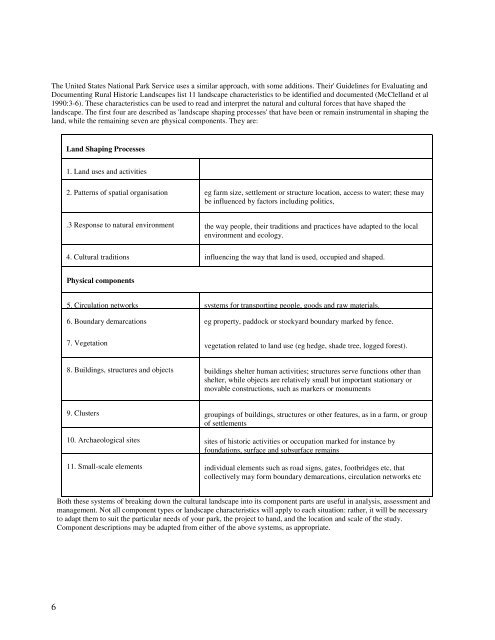The United States <strong>National</strong> Park Service uses a similar approach, with some additions. Their' Guidelines for Evaluating andDocumenting Rural Historic <strong>Landscape</strong>s list 11 landscape characteristics to be identified and documented (McClelland et al1990:3-6). These characteristics can be used to read and interpret the natural and cultural forces that have shaped thelandscape. The first four are described as 'landscape shaping processes' that have been or remain instrumental in shaping theland, while the remaining seven are physical components. They are:Land Shaping Processes1. Land uses and activities2. Patterns of spatial organisation eg farm size, settlement or structure location, access to water; these maybe influenced by factors including politics,.3 Response to natural environment the way people, their traditions and practices have adapted to the localenvironment and ecology.4. <strong>Cultural</strong> traditions influencing the way that land is used, occupied and shaped.Physical components5. Circulation networks systems for transporting people, goods and raw materials.6. Boundary demarcationseg property, paddock or stockyard boundary marked by fence.7. Vegetationvegetation related to land use (eg hedge, shade tree, logged forest).8. Buildings, structures and objects buildings shelter human activities; structures serve functions other thanshelter, while objects are relatively small but important stationary ormovable constructions, such as markers or monuments9. Clusters groupings of buildings, structures or other features, as in a farm, or groupof settlements10. Archaeological sites sites of historic activities or occupation marked for instance byfoundations, surface and subsurface remains11. Small-scale elements individual elements such as road signs, gates, footbridges etc, thatcollectively may form boundary demarcations, circulation networks etcBoth these systems of breaking down the cultural landscape into its component parts are useful in analysis, assessment andmanagement. Not all component types or landscape characteristics will apply to each situation: rather, it will be necessaryto adapt them to suit the particular needs of your park, the project to hand, and the location and scale of the study.Component descriptions may be adapted from either of the above systems, as appropriate.6
1.4 The scale of cultural landscapes: determining boundariesThe above discussions suggest that scale is an important consideration in the study, assessment andmanagement of cultural landscapes. As noted, a cultural landscape is an extensive, integratedmanagement unit, not just the 'dots on the maps' representing historic features and their immediatesurrounds. Thus attention to both the broadscale landscape and the finer component features is required,for integrated cultural landscape analysis, assessment and management.The scale, dimensions and forms of cultural landscapes will vary immensely, and may range from quitesmall, contained landscapes (such as a small farm with paddocks, fences and associated structures on fertilecreek flats in a small section of a narrow valley, including transport routes to the property), to vast,extensive areas covering many square kilometres (such as a forest whose species composition and agestructure has been changed through logging and silvicultural practices). Smaller cultural landscapes maythemselves form part of more extensive cultural landscape areas, such as a group of pastoral settlementsspread over a wide area, or as mentioned above, locations along a stock movement or transportation route.Determining boundaries of cultural landscapes is necessary for analysis, assessment and managementpurposes. The concentration, continuity and integrity of cultural landscape characteristics that showsignificant historical themes should be used as a guide to defining boundaries (McClelland et al 1990).Historic research and ground surveys of the landscape will help determine appropriate edges, such as oldsurvey or property documents defining the extent of land ownership, diaries or oral history detailing whereactivities took place, and physical evidence of borders, fences or hedges still discernible on the ground.It is important to bear in mind the role that cultural landscapes and their management may play inbroader landscape management. For instance, a cultural landscape may itself be an importantcomponent of a view from a point outside the landscape.1.5 Significance of cultural landscapes (ie. their historical content)<strong>Cultural</strong> landscapes, by definition, have a strong historical component. Human use of the landscapegenerally creates distinctive physical patterns, resulting in a cultural landscape that expresses past humanattitudes and values, and exists as an artefact composed of identifiable physical remains. Determining thehistoric significance of these patterns and remains is central to the task of assessing the value of culturallandscapes."Historic significance exists in a landscape where the landscape or its components havestrong links to or associations with important historic themes, and where the evidence assistsin understanding the past. "Many of the important historic themes for the <strong>Alps</strong> <strong>National</strong> <strong>Parks</strong> have been identified, and are detailed inPart 2. Significance can be established at local, regional or national levels. How significant a culturallandscape or feature is will determine the conservation policy prepared for it, and how it is managed. Theprocess of determining historic significance is discussed in Part 4 of this report. This section also looks atother categories of significance. Part 5 addresses conservation policy and management.7
















